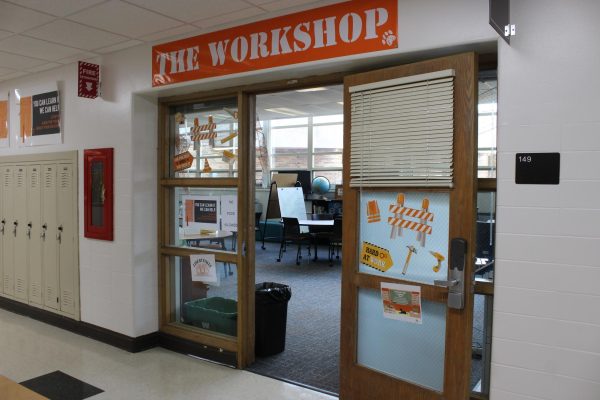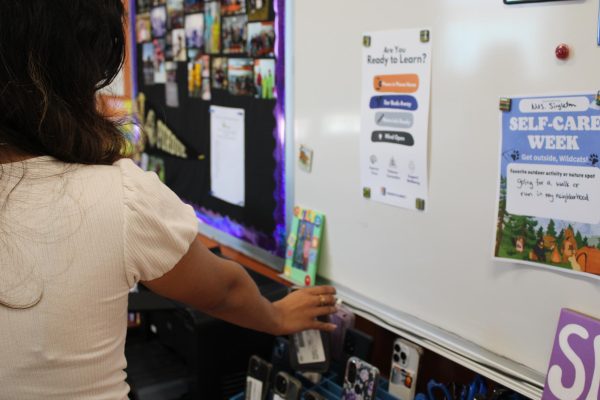Yearbook Staff Provides Coverage While Adapting
The yearbook staff, under the direction of Editor-in-Chief Julia Hasler and adviser Kristen Connelly, will once again strive for perfection in this year’s yearbook — even during the unusual times that Covid-19 has brought — just like they have in past years.
Throughout first semester, the yearbook staff has acclimated to the limitations of the pandemic on in-person events and has devised creative approaches to ensure school coverage.
One major alteration to their deadline schedule is the distribution date, which will be postponed to the end of summer 2021 rather than May. According to the yearbook advisor, Kristen Connolly, one reason for this decision is to incorporate spring and summer sports instead of distributing the usual supplement.
The staff traditionally utilizes a ladder system to coordinate their yearbook spreads, which refers to two side-by-side pages of a yearbook. The ladder system is a breakdown of all categories and topics addressed for the year.
“We have adapted the book this year to fit what works best with the remote style of learning and with the chance of activities being canceled, so we are covering topics as they come to us,” elaborated senior Julia Hasler, the yearbook’s editor-in-chief.
Junior Maddy Tepper, an assistant editor-in-chief, added that some of the pages, such as the fall sports spreads, will resemble previous yearbooks in appearance and content, thanks to the yearbook’s access to Visual Imaging Photography photos.
As an example, this year’s book will still feature the fall theater performance but will depict a drive-through performance instead of the traditional auditorium event.
However, due to the pandemic, the staff was unable to formulate a clear blueprint of their pages at the beginning of the school year.
“It’s kind of affected how we plan, and [shows how] we just have to go with the flow more,” expressed junior Sarah Rubenstein, an assistant editor-in-chief of the yearbook.
With the extended deadline, Hasler clarified that the yearbook team still intends to fill the entire book, all 272 pages of it. The staff will feature future events, such as the transition to hybrid learning, as well as graduation and prom, if these occasions occur in some capacity.
Additional topics of spreads in the upcoming yearbook include the prevalence of activism, socially distant connections, forms of pandemic protection and District 128’s COVID-19 testing sites. The staff has sent surveys out to students to gather data for their pages.
Compared to last spring, Rubenstein mentioned this year’s approach is more flexible, enabling the staff to modify their ladder system more efficiently. The yearbook staff has reserved open spreads for any short-notice changes that may occur due to COVID-19.
Additionally, Tepper specified that Zoom has permitted the staff to be more productive: “We can send [staff members] into breakout rooms and talk privately or go over a copy together and screen share, so that’s something that I don’t necessarily mind.”
On the other hand, Mrs. Connolly recounted the difficulty of receiving responses for interviews and gathering photos. Specifically for pictures, staff members collaborate virtually with club advisors to obtain photos or screenshots of Zoom calls.
Despite these challenges, Mrs. Connolly believes that the yearbook would have struggled more significantly this year without the dedication and motivation of the editors.
She also emphasized the importance of the yearbook, especially during the COVID-19 pandemic. She illustrated that years from now, students will have the ability to reflect upon 2020 and 2021 with their yearbook.
“We are still trying to capture the sights and sounds of the school year so when people look back, they have this to look back on,” Mrs. Connolly commented.
Rubenstein expressed that the yearbook staff wanted students to be able to recall their moments at LHS vividly.
Hasler agreed, adding, “With any yearbook, the main goal is we are not [just] making a book. We are making memories and that’s the most important part.”





![Wildcats do their pre -race circle that consists of chants and cheers to hype up the team. “I think cross country is such an interesting sport, in the way we're all kind of struggling together at the same time," senior Emme Fogle said. "[We have] comfort knowing that everyone's kind of going through the same thing. It's kind of incredible.”](https://www.lhsdoi.com/wp-content/uploads/2025/09/Screenshot-2025-09-25-3.14.42-PM-600x361.png)





